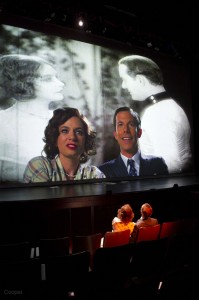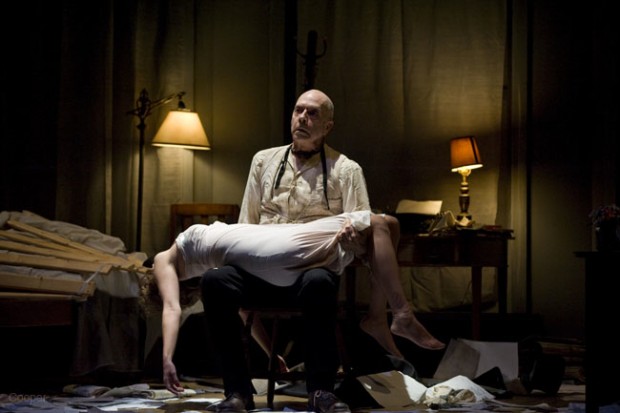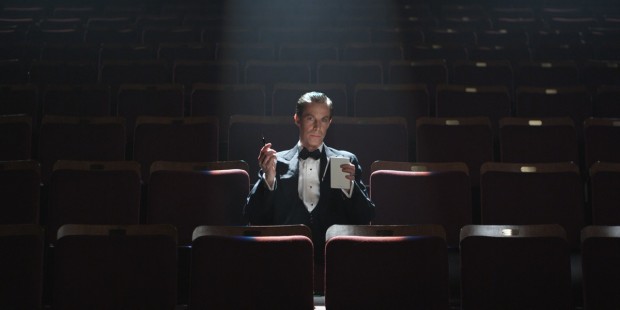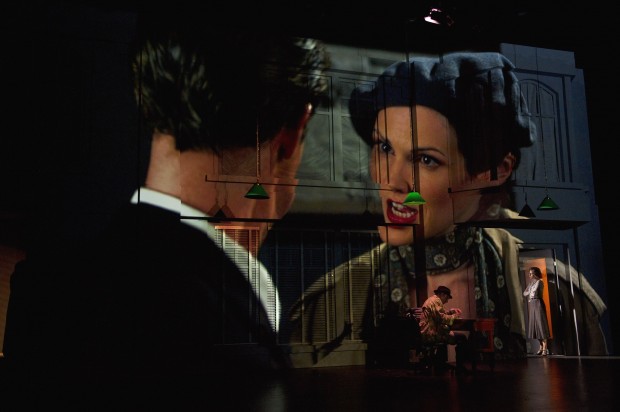
Jonathon Young and Laura Mennell on film with Scott Bellis and Dawn Petten on stage
by Michael Wheeler
I wonder if this is what embedded journalists feel like?
After two trips to Vancouver to participate in both the filmed and theatrical execution of this project, it is impossible to provide anything approaching an unsentimental analysis of it. I really like the show, the people who made it, and I sincerely hope it comes to Ontario someday so I can show it to people.
I’m sure it will inspire a number of conversations about performance and form: Is it a movie? Is it a play? If it is a hybrid of both, what do you call it? I think it is something else entirely however:
I think Tear The Curtain! is an ode.
The production begins with a film clip of theatre critic Alex Braithwaite being driven to review a performance by his secretary Mavis:
MAVIS
You know what your trouble is?
ALEX
I’m a hack writer living in a hick town.
MAVIS
No.
ALEX
A hick border town where we’re raised on foreign ideas and foreign stories which we imitate, pretending they’re our own… I should have left when I was twenty and gone where the action is.
MAVIS
You just don’t know what you want Alex. I’m sure we may be hicks compared with other places, but don’t deny yourself the privilege that gives you.
ALEX
What privilege?
MAVIS
The freedom to create our own future.
Theatrically, Tear The Curtain goes on to embody this conversation by becoming a piece of theatre that lives within the constraints of this debate by doing something new and exciting, while acknowledging the cultural constraints of living in a city fifty clicks from the United States. Recognizing and integrating the generations of storytellers and shifts in technology that have come before them, the production sets out to be a performance that uses new forms and tools to re-imagine Vancouver within an archetypically American film noir aesthetic.
This is why I think Tear The Curtain an ode. It is not just film noir gangsters, dames, and crazy film integration within a vacuum. It is an ode to the City of Vancouver. It is attached to a particular perspective about what it means to make art in this place, in this era, and everything that generations of artists have gone through to arrive at where they are today.
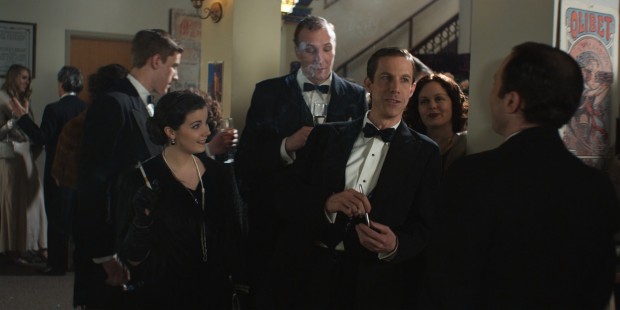
My part in one of the film clips is so incidental that there are no stills of me with my eyes open. (If you listen very carefully however, you can hear me chuckle at one of Alex Braithwaite's jokes.)
Like the rest of this process, tech at The Stanley Theatre was a whirlwind of activity. What distinguished this week-long period where actors and designers finally integrate their offerings from most, was the extra factors that had to be set in tandem with all the regular ones a director would consider. Each moment is precious in the time you have from when you move into the theatre to to opening night.
Because many of the filmed segments had audio scored directly for the image on the video, but the audio cues for the live action were being set as we established actor blocking, there was a lot to think about in terms of what audio was coming, at what level, and was it attached to the film or called live. Often when audio was activated was related to the fly system for the show, which incorporates three different curtains, a scrim, and a very large wall that are continually emerging from, or disappearing into, the air above the stage
Even the simplest video elements in a performance piece can devour precious tech time, but the scale and resolution of the images captured by the Red camera posed particular challenges for Video Wrangler Michael Sider:
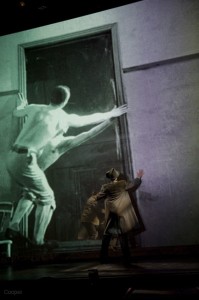
My favourite thing about this scene is that the projected image actually exists legitimately within the given circumstances of the story.
To get the largest, richest image to fill the entire scrim, two identical projectors are broadcasting simultaneously, mounted parallel to one another. These images are also broadcast on different surfaces that are varying distances away from the projectors, so each surface has to have its own focus where the images from the two projectors overlaps correctly.
Separate from projector concerns, once we moved into the theatre, many video sequences needed to have small adjustments made on the fly. A number of factors including small text changes, the timing of scored audio, and blocking adjustments, meant many scenes needed to be shortened or lengthened, or faded in slower or faster, than how we had been working with them back at Progress Lab.
Lighting Designer Alan Brodie faced his own particular challenges working with mixed mediums: The lighting hang used the maximum amount of dimmers available for lighting equipment in The Stanley Theatre. The show requires this many lights because a number of the focuses occur though the light that is video, through or around a scrim, on or within a three-dimensional two-story set, in the house, or any combination of those factors.
Additionally he was charged with using all of this light to maintain a dark, cold, and smoky film noir aesthetic already captured by cinematographer Brian Johnson in the filmed sequences. This had been planned at length in meetings with Director Kim Collier as the three of them established together the visual qualities of the world they would create before either the film or play had been made.
All of these elements are called by Stage Manager Jan Hodgson, who had been practising activating and integrating these elements verbally in the rehearsal hall. Tech involved incorporating new elements and timing as well as actually working with the real things. Most importantly, it was the time to gain an understanding of the rhythm of the show.
There is music to how all these components are related and need to be called. In many ways the art of this production relies on the way the stage manager understands the music the director is playing in all these cues, as much as it does performances on the stage. Although depends a lot on those too. As I put the finishing touches on this piece on a crisp Toronto morning – two days separated from The Electric Company, my thoughts turn to all of the performers in the show:
Today is opening night day! I think the opportunity to be on a stage like doing this show, at this place and time, has a lot to do with why performers gravitate to the theatre, and this is ultimately why Tear The Curtain is a piece of theatre (in the form of an ode). You will never get that feeling on a film set; you have to be there alive in that room with the other people who have chosen to be there, to know what it is. Wish I could be there to share it with them.
Merde!
]]>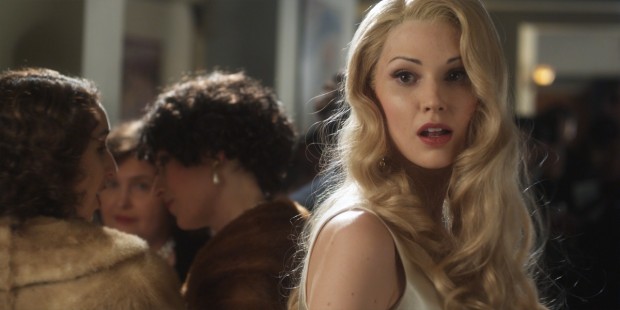
Laura Mennell plays the mysterious Mila Brook in The Electric Company's Tear The Curtain. Photo by Brian Johnson.
by Michael Wheeler
One of the unconventional things about this residency is that unlike a traditional curriculum that would begin with basic fundamentals and conclude with something grand and complicated, I am taking the best opportunities I can get when they are available. This approach led me to begin my training program by participating in the first half of a 3-week film shoot for The Electric Company’s newest production – Tear The Curtain, commissioned by The Arts Club Theatre Company to open at The Stanley Theatre in Vancouver in early September 2010.
This meant my cross-Canada study of the relationship between direction and design in theatre began with a crash course in how to direct a film. It took me a couple of days on set, and a couple of reads of the integrated script (which overall is formatted as a film not theatre script), to fully appreciate the magnitude and ambition of what I had gotten myself into.
The story operates on two levels: Plot-wise it is a film-noir styled story set in a semi-fictional Vancouver full of gangsters, tycoons, a secret cell of revolutionaries and double-crossing vixens. Fundamentally it is a narrative that will entertain. Thematically, it attempts something very complex and intricate by centring the plot around an embittered theatre critic in an era where film is becoming the dominant medium. The lead character is both fighting this shift, in part to keep his livelihood, and searching for the reason he was so enamoured with theatre to begin with.
This is not just an intellectual existential problem for the lead character to be considered by an audience. The show is a combination of both mediums. The Stanley Theatre – where the show will premiere – was once a movie theatre that has been transformed into a theatre theatre. All of the filmed sequences have been shot with in the Stanley Theatre and many of the shots are from the audience’s POV of the stage – or acknowledge in some way when that they were shot in the same room where the audience will experience the performance. Experientially – the line between film and theatre as mediums will be blurred as the same actors from the filmed portions will also tell the story through live scenes.
Still with me? Also, all of this was happening in the heart of Vancouver in the middle of the Olympics. Not too many of the huge crew of people that were working three weeks of consecutive 12hr days seemed all that aware of snowboard cross, curling or the luge – even though the Olympic village was around the corner. We had important things to do! (Not entirely true: Managing Producer Nathan Medd scored last minute tickets with his family to the Opening Ceremonies and came back with some impressive photos on his iPhone.)
My role was to observe – and occasionally be a sounding board for – director Kim Collier as she tore through an ambitious and demanding shooting schedule. Although I have been on film sets before, I have never considered each day and shot, from a director’s perspective, as such the learning curve was both steep and fascinating. One of my first realizations was that a production that used a large number of professionally filmed segments like this had only recently been made possible, or at least economically feasible, by new technology. The film sections are not actually shot on film; a RED One high-res camera was used. This is considerably cheaper than shooting on film and allows all of the information to be stored digitally and viewed immediately.
This technology is not flawless. RED One cameras are a little too good – they can show too much detail and not have the pleasant hues that come from shooting on film. To combat this effect – and to contribute to a film noir-ish feel throughout, there was a single person whose only job was to keep a thin mist of haze circulating whenever camera was rolling. Keeping this haze perpetual and consistent was a major battle throughout each day, but was key to both the atmosphere and continuity of the material being filmed.
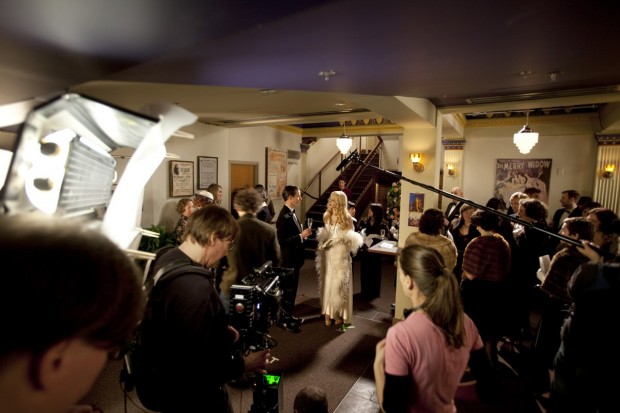
Kim Collier (foreground right) directs while a Red One camera is operated by a RoboCop-like suit wearing cameraman. Photo by Tim Matheson.
A second element that jumped out at me as a theatre director learning to direct film was how little time there is for experimentation or mistakes. In theatre I think our creative process often leads us to take time feeling our way into things, trying different approaches, and sometimes using good ol’ trial and error. This is not even remotely a possibility on a film shoot – not only do you have to know exactly what shot you want ahead of time, but exactly what you want from each of your actors and your DP for each individual shot well ahead of time. Certainly you can make adjustments on the fly and always keep your eyes open for discoveries and opportunities – but time is money and a professional film crew is a lot of people’s time.
The biggest day of the shoot was my last one, when a huge number of extras were used to create the crowd shots both of the audience filling the theatre and of a party in that occurs in the lobby of the theatre. On that day over seventy volunteer actors (myself included) showed up at 8am on a Saturday to be dressed in high fashion of the 1930s and strike a number of sophisticated poses and while feigning conversation throughout the day. Most ingenious use of the RED One Camera occurred at the end of this day when the seventy actors were shuffled to completely fill small sections of the 600ish seats the theatre with the camera “locked down”. Later in the editing room these multiple iterations of ourselves will become citizens of the same time and space filling the entire audience in a single shot.
I am already looking forward to returning to Vancouver to join the theatre portion of rehearsals for Tear The Curtain leading up to an early September opening night. The whole company has been awfully nice to a guy from Toronto whom they’d never met before, and it was awesome to be included in this ambitious process. I’m looking forwards to learning the process by which The Electric Company and Director Kim Collier integrate the filmed and live materials both in the rehearsal hall and in tech at The Stanley Theatre. Next post – Michael Healey’s Courageous arrives at The Citadel Theatre in Edmonton.
]]>